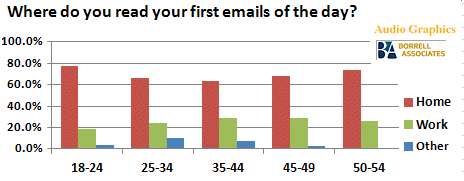 Analytics, Metrics and Music for the Radio Industry
Analytics, Metrics and Music for the Radio Industry
 An Indie Artist Pipeline to Internet Radio
An Indie Artist Pipeline to Internet Radio
 Radio Industry ROI Strategy
Radio Industry ROI Strategy
 A New Breed of Indie Artists
A New Breed of Indie Artists
Internet Radio Listeners and Email
Try to find data on email and it's a catch-as-catch-can game. There are many web sites that speak about the topic, but few offer up-to-date stats. Attempt to isolate email use relative to the radio industry, and the problem magnifies.
With completion of the latest Audio Graphics survey of online radio's audience (conducted with support from Borrell Associates), we can now answer a few questions. Survey 53 had 1,020 individuals giving us the lowdown on where they first read their daily emails, which device is used most to read emails, and an approximation of how many emails are received daily (excluding spam). There are a few surprises. (See report here.)
| "...installing a routine for sending emails to the audience should be in every radio executive's plan." |
Before getting into the meat of this internet radio listener survey (which Audio Graphics has been conducting continuously since 2002), let me comment about what I've come to expect from email. On the receiving end, through server logs, I can state that approximately 92% of email trying to make its way to my inbox is spam. Checking with a long-time friend, who is closer to a server farm than I am, confirms this rate is standard throughout his many clients. It's important to note that this 92% figure represents the number of emails being sent, not those making their way into your mailbox. These are stopped by filters at the hosting/ISP level. |
As for the use of email in marketing, there is no doubt in my mind that, for the effort invested, email delivers a higher rate of return for Audio Graphics than any other form of communications. The caveat to this is that I run a very clean set of email lists, typically delivering a very low bounce-rate of around 0.43%-1.2% (depending on which list is used). Removal requests are even lower, averaging about 0.2% per mailing. A strong benefit is realized when you put energy into scrubbing a mailing list after each use; efficiency increases with each mailing.
As for our Survey 53, view the general report here. To receive a detailed report, simply have your station place the survey on its web site. Each survey serving stations gets the details in granularity, and each survey is relative to the radio industry online - which helps improve programming and business decisions.
Diving into the data, let us first explore the issue of volume of daily emails because it indicates how much clutter your email will have to cut through for attention. Survey 53 concentrates on the 18-54 demos. Here's how respondents answered the question, "Not counting spam, on average, how many emails do you receive per day?"

There is a noticeable difference in the age groups of 18-34 and 35+ in this category - with the former receiving mostly 0-5 emails daily, while the older demos all claim that receiving 11-20 emails daily is their routine.
Your first thought may be that this is because of smartphone use in younger demos, but let's look at which devices are used to retrieve email next.
On what type of device do you most often read email?

Finally, let's look at where people first check for their daily email - 69% of respondents indicate it's at "home," with a quarter (25%) waiting until they get to work to first check incoming emails. Here's how the breakout goes by age group.

A Datran Media survey shows that "39.4% of marketing industry executives called Email Marketing the most powerful advertising channel for their business."
And, according to an eMarketer's report on a survey conducted by BtoB Magazine, 68% of respondents indicated they were planning to increase email marketing budgets in 2011.
Email's downside, and it's one that should not be ignored, is a rate of "undeliverables" estimated to approach 19%. But, if you track an email campaign properly, it is a simple process to quantify results by attaching an action within an email back to the originating web site.
For the radio industry, with its power to gather opt-in email addresses, installing a routine for sending emails to the audience should be in every radio executive's plan.
As I wrote in an August column titled Getting the Most From an Email Campaign, "Social media may be what's hot in the radio industry, but don't do it at the expense of email contact."
Survey 53 shows that email still holds a place in everyone's day.
There may be plenty of spam, but legitimate email messages still carry weight.










